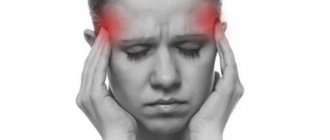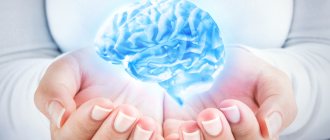There are about 200 known causes of headaches (cephalalgia). This may be an increase or decrease in blood pressure, pathology of cerebral vessels, diseases of the spine, brain vessels, brain tumors, intoxication. At the Yusupov Hospital, neurologists find out the cause of headaches using the latest diagnostic equipment from the world's leading manufacturers.
Headaches in the forehead can bother a patient with sinusitis or frontal sinusitis. In this case, treatment is carried out by otolaryngologists. If the cause of the headache is arterial hypertension, cardiologists provide antihypertensive therapy. In the presence of intoxication, infectious disease specialists treat patients with headaches. A multidisciplinary approach to the treatment of patients suffering from headaches can quickly improve the patient's condition.
Causes of headaches in women
When developing tactics for managing a patient with headache, neurologists at the Yusupov Hospital take into account its cause. Doctors relieve headaches with analgesics and at the same time treat the disease that caused this syndrome. Most often, headaches in women occur for the following reasons:
- Hormonal imbalances;
- Acute or chronic stress;
- Increase or decrease in blood pressure;
- Dysfunction of the autonomic nervous system;
- Diabetes mellitus;
- Infectious diseases (meningitis, encephalitis, tuberculosis);
- Inflammation of the neck muscles:
- Osteochondrosis of the cervical spine;
- Volumetric formations of the brain.
Causes of headaches in men
Men are most often bothered by cluster pain. It is localized in the temple area and the eyeball. Pain of varying intensity in men occurs during a respiratory disease, an infectious lesion of the body, after an injury, or during the development of a brain tumor. Headaches localized in the back of the head occur with arterial hypertension, stroke, and traumatic brain injury. Often men experience severe headaches accompanied by nosebleeds. The reasons for the violation may be:
- Diseases of the circulatory system;
- Failure of endocrine organs;
- Cardiovascular diseases;
- Meningitis.
- Stroke;
- Tumors of the brain or nasal cavity;
- Hypertension;
- Overwork.
Expert opinion
Author:
Tatyana Aleksandrovna Kosova
Head of the Department of Rehabilitation Medicine, neurologist, reflexologist
90% of the population has experienced headache symptoms at least once in their life. Such data is provided by the World Health Organization. In 20% of cases, the headache is permanent. The ratio in the morbidity structure among men and women is 1:3. Neurologists identify various causes of headaches. The most common etiological factors are migraine and tension headache. Migraine is diagnosed in 20–30% of cases, and tension headaches account for 50–70%.
A headache can be a symptom of a serious illness. Therefore, if a pathological sign appears frequently, as well as in the presence of other symptoms, you should consult a doctor. At the Yusupov Hospital, neurologists pay close attention to the treatment of various types of headaches. Diagnosis of possible causes is carried out using x-rays, MRI, CT, EEG, angiography and laboratory tests. If necessary, additional studies are prescribed. Individually selected therapy allows you to stop an acute attack and prevent the re-development of the pathological symptom. The drugs used are verified for quality and safety. Treatment regimens comply with international recommendations for headache therapy.
The main causes of cephalalgia
Acute pain in the head and throbbing prevents a person from living a normal life and doing business. If pain appears once, this does not necessarily indicate the presence of dysfunction in the body. In cases where a person experiences cephalalgia more and more often, and the pain lasts longer and longer, there really is a problem in the body. It needs to be eliminated, and only a specialist can handle it.
Doctors identify a number of main reasons that cause this symptom, namely:
- VSD (vegetative-vascular dystonia);
- atherosclerosis;
- sinusitis, sinusitis;
- migraine;
- eye diseases;
- hematomas;
- tumors;
- neuralgia;
- stress.
Vegetovascular dystonia
Pulsating pain is called background pain. It occurs due to a decrease in the tone of cerebral vessels, stagnation of blood, and spasms of the arteries. The difference between pain that appears due to VSD is that “jolts” do not depend on the person’s pulse.
Atherosclerosis
If a patient has problems with the vascular system, he begins to suffer from pulsation in the temporal and occipital areas of the head. But the zones can change, and the sensations can become oppressive over time.
Sinusitis, sinusitis
The reason lies in the cold you suffered, namely its complications. In order not to encounter cephalalgia, it is imperative to cure all viral and infectious diseases. The same applies to a runny nose.
Migraine
Migraine is manifested by a pulsation, which patients describe as if it were pounding right under the skin, and the pain is localized in one part of the head at the top.
Scientists have not yet proven the definitive causes of such pain, and the exact forms of manifestation of the disease have not yet been determined.
But still, there are several possible causes of migraine development, namely:
- food products (several types of cheeses and sausages);
- weather sensitivity;
- smells of ammonia, ammonia, perfume;
- serious physical activity;
- emotional outburst;
- uncomfortable body position for a long time.
A migraine can torment a person for more than one day. There are cases when the pain lasts 3 days. Most often, cephalalgia caused by this problem manifests itself in unbearably severe pain, and can go away after a few hours. Doctors note the fact that females suffer more from this.
At the end of a migraine attack, a person notes that he has severe weakness and a tendency to sleep.
Eye diseases
The following reasons that can provoke pulsation are eye diseases. A large number of people turn to specialists with complaints such as blurred vision, nausea, dizziness, photophobia, and acute pain radiating to the eye. A competent doctor will immediately determine that these are symptoms of angle-closure glaucoma - high intraocular pressure.
Cephalgia can develop due to tension in the optic nerve, which occurs due to incorrectly selected diopters of glasses or lenses. But in such cases, dizziness also appears.
Hematomas, tumors
Pulsating pain of a strong nature, which is clearly localized in one of the areas of the head, may indicate the presence of damage or a neoplasm. Also in this case, it is worth noting the presence of nausea and vomiting.
If such symptoms are noticed, you must quickly contact a specialist to diagnose a tumor or other problem and begin to treat it.
Stress
All overwork and emotional turmoil can result in severe headaches. Constant nervous tension and stress can create a “fellow traveler” for you for the whole day, namely cephalgia.
Neuralgia
Another common reason why such unpleasant sensations occur in the temple and head area. Dental problems, trigeminal neuralgia - all this provokes pain.
Other causes of cephalalgia
Osteochondrosis and a number of other problems associated with the cervical spine can provoke throbbing pain.
In winter, pulsation in the back of the head often occurs. This is explained by hypothermia and a sharp narrowing of blood vessels.
Lack of normal rest, disruption of sleep quality and routine can cause headaches.
Bad habits are also included in this list of “provocateurs”. They not only harm health, but can also cause discomfort to a person in the form of cephalgia. If a person often drank coffee and decided to abruptly stop, this can also provoke this problem, since the blood vessels are not able to return to normal so quickly.
Not everyone knows, but what we eat can also cause throbbing in our temples. These products include: chicken liver, cheeses, sausages, bacon, nuts, yogurt.
Kinds
Neurologists distinguish the following types of headaches:
- Migraine – caused by a disruption of the vascular system;
- Tension headache - mainly occurs due to excessive tension in the neck, eye muscles, as well as the muscles of the shoulder girdle and scalp aponeurosis, as well as due to chronic stress, depression;
- Chronic paroxysmal hemicrania, cluster headache - can be primary or secondary.
- Headache not associated with damage to brain structures;
- Ambus headache that occurs when taking medications uncontrolled.
There are also headaches after traumatic brain injury, with diseases of the vascular system, and those that occur with intracranial disorders of extravascular origin.
Tensor headaches often occur in women after stress or nervous shock. It goes away in the presence of positive emotions, after drinking soothing herbal teas.
Neurologists do not recommend taking headache pills on your own. Each drug is designed to relieve a specific type of pain and has a number of contraindications. The doctor takes all this into account when prescribing a medicine to a patient.
Make an appointment
Treatment
Conservative therapy
The treatment plan is drawn up taking into account the nature of the disease. The following medications and non-drug methods are used:
- Migraine.
To eliminate paroxysms, non-narcotic analgesics are prescribed. For persistent attacks, blockades are performed. For intense excruciating pain and migraine status, triptans are used in tablets, rectal suppositories, and solutions for parenteral administration. The last two options allow you to solve the problem of taking the drug for persistent vomiting. - Paroxysmal hemicrania.
NSAIDs, glucocorticosteroids, and calcium channel blockers are effective. Depending on the severity of the pathology, medications are taken in short courses or continuously. - Cluster headache.
Painful attacks are eliminated with the help of triptans and applications of local anesthetics to the nasal mucosa. The effectiveness of inhalation of 100% oxygen is noted. Preventive measures in the interictal period are carried out using calcium channel blockers, hormonal, and antiepileptic medications. - Hypnic headache.
The basis of treatment is hypnotics, lithium preparations, and atypical benzodiazepines. Some researchers have reported the effectiveness of steroids and NSAIDs. Before going to bed, patients are advised to take caffeine-containing and melatonin-containing medications. - Vertebrobasilar insufficiency.
Antiplatelet agents, anticoagulants, neuroprotectors, antihypertensive, vascular drugs, exercise therapy, massage, manual therapy, hyperbaric oxygenation, magnetic therapy, laser therapy are recommended. - Tumors.
To reduce the severity of symptoms, non-narcotic and narcotic analgesics, antiemetics, glucocorticoids, and psychotropic drugs are used. Radiation and chemotherapy are carried out as part of palliative therapy or are part of complex treatment in the pre- and postoperative period. - Spinal pathologies.
Pain is eliminated with the help of oral and parenteral forms of NSAIDs, muscle relaxants, and local administration of glucocorticosteroids. They use B vitamins, neurometabolites, phonophoresis, UHF, electrophoresis, and magnetic therapy. - ENT diseases.
Treatment regimens include antibacterial, vasoconstrictor, antihistamines, physiotherapy, paracentesis of the tympanic membrane, and puncture of the paranasal sinuses.
Surgery
Treatment of primary cephalgia is only conservative. For other pathologies, the following may be indicated:
- Vertebrobasilar insufficiency
: reconstructive surgery to restore blood flow. - Brain neoplasia
: removal of cerebral tumors using traditional and minimally invasive surgical techniques. - Spinal diseases
: low-traumatic (endoscopic microdiscectomy, puncture laser vaporization) and traditional (discectomy) interventions for hernias, sometimes in combination with fixation operations. - Pathologies of ENT organs
: sanitizing surgery, mastoidotomy, frontotomy, maxillary sinusotomy, micromaxillary sinusotomy.
Migraine
Migraine is the most common type of headache.
It most often occurs in women from the onset of puberty (from 11-13 years) to 35 years. Migraine can be simple or with an aura. It can occur in the temple, crown, back of the head, and forehead. The cause of the disease is a hereditary disorder of vasomotor regulation of arteries located outside and inside the cranium. With migraines, headaches occur in the form of attacks. They bother you at varying frequencies - from once a week to once a year. The attack lasts from several hours to 3 days. Usually the pain is throbbing and covers half of the head. It often occurs after physical activity, stress, lack of sleep or too much sleep, or eating certain foods. A migraine attack is accompanied by nausea and vomiting, intolerance to bright light, noise, and strong odors. Sometimes the headache is very severe and lasts for several days - this condition is called status migraine. According to statistics, migraine occurs in 2% of people.
Neurologists believe that a migraine attack develops under the influence of the following provoking factors:
- Chronic stress;
- Overwork;
- Intense mental work;
- Hormonal disorders.
Often the cause of migraine is a family history.
Tension headache
This type of headache occurs as a result of prolonged tension in the muscles of the head and neck.
Tension headaches can be chronic and bother you constantly, only sometimes stopping for 2-3 days. There are no other violations. There is no nausea or vomiting, bright lights and loud noise do not cause suffering. Almost all sick people lead a normal life and have normal performance. Tension headaches often affect people with increased anxiety and a tendency to become depressed. Pain often occurs against the background of severe stress. There is a feeling of pressure on the top of the head or compression of the entire head. Many people suffering from this disorder take a lot of painkillers on a regular basis. Over time, this “treatment” can itself lead to headaches. Tension headaches are treated with antidepressants - only a doctor can prescribe them. Head massage and acupuncture help improve the condition.
In the eye and forehead area
Headaches in the forehead area are caused by various factors.
Cluster or beam pain occurs in the eye area. She may return after a while. Sometimes attacks continue for several hours. A headache that radiates to the eyeball can be a sign of migraine, eye diseases, brain tumors, and neurological diseases of the brain. It often occurs after severe or prolonged stress. The cause of the headache may be inflammation of the maxillary or frontal sinuses. It often radiates into the eyeballs. Sinus headache disappears after the underlying disease is cured. Pain in the forehead is a common symptom of meningitis, malaria, typhoid, and pneumonia.
Causes
Noises in a person’s head are not always a symptom of pathology. Many sounds arise in our body during its life - during blood flow, joint movement, contraction and relaxation of muscles. They are masked by other sounds present around us and seem invisible to us, and in conditions of complete silence we can pay attention to them.
However, in most situations, extraneous noise, humming and other sounds in the head or ears are a sign of a pathological condition and a reason to contact a specialist.
Vibrator noise is caused by:
- diseases of the temporomandibular joint;
- neuromuscular diseases (gap of the auditory tube, myoclonus of the muscles of the soft palate, middle ear);
- changes in blood vessels (heart valve defects, narrowing of arteries, problems with veins, arteriovenous shunts).
Subjective noise may be based on:
- metabolic disorders (diabetes mellitus, thyrotoxicosis, hyperglycemia, hypoglycemia, atherosclerosis);
- brain tumors;
- neuroma of the VIII pair of cranial nerves;
- diseases of the hearing organ (cerumen plug, otitis, sensorineural hearing loss, labyrinthitis, neoplasms, Meniere's disease, trauma);
- damage by toxic substances (medicines that have a toxic effect on the organ of hearing, methyl alcohol and others);
- diseases of the spine (degenerative-dystrophic changes, instability and others);
- neurological diseases (acute and chronic cerebrovascular accidents, multiple sclerosis, neurocirculatory (vegetative-vascular) dystonia);
- hypertonic disease;
- mental disorders (neurasthenia and other neurotic disorders, depression, schizophrenia);
- exposure to noise and vibration in production;
- traumatic brain injuries (bruises, contusions).
Shpidonov Gennady Stanislavovich
Neurologist
Rostov State Medical University (neurology)
10 years of experience
In the occipital region of the head
In the back of the head, cephalgia occurs when blood pressure increases, the cause of which is osteochondrosis, spondylosis, spondylolisthesis, anomalies in the development of blood vessels in the head or neck.
Severe pain in the back of the head occurs after nervous strain, as a result of spasm of the neck muscles, arteries of the head and neck, and disruption of the outflow of venous blood from the head. It worries patients suffering from occipital neuralgia, vertebrobasilar insufficiency, spinal diseases, and migraines. A sharp headache in the back of the head often occurs with the development of a hypertensive crisis. Sharp, bursting, pulsating headaches in the back of the head are accompanied by pallor of the patient’s face, generalized hyperhidrosis, dry mouth, heart pain and tachycardia.
Chronic arterial hypertension with a slight increase in blood pressure is also characterized by the development of pain mainly in the occipital part of the head. The headache bothers the patient immediately after waking up, intensifies with physical activity, and is often accompanied by swelling of the lower eyelids. Pain is caused by a violation of the outflow of venous blood from the vessels of the head.
Pain in the frontal part of the head
The forehead is a part of the body on a person’s head, located from the eyebrows below to the base of the hair above. The sides of the forehead are limited by the temples. Pain in the frontal part of the head can be caused by a variety of reasons. The forehead can hurt due to inflammation of the sinuses, teeth, migraines, allergies, and prolonged stress.
Causes of pain in the frontal part of the head
Headache in the frontal part spreads from the neck to the back of the head, temples, eye area, on one or both sides. May be accompanied by the following characteristic symptoms:
- dizziness;
- staggering;
- nausea.
You can feel the pain points in the back of the head and neck. The pain is dull, monotonous, pressing, squeezing or bursting. The localization of pain is usually felt around the head, in the frontal part of the head and eyes, temples, under the back of the head, sometimes reminiscent of tightening the head with a ribbon or a tight cap. It is usually provoked by mental stress and fatigue. Occurs against a background of nervous exhaustion or severe mental stress . The cause is usually a psychological problem, especially excessive efforts that do not lead to the desired result and outcome, anxiety or depression.
Headache with increased intracranial pressure
This subtype of headache occurs in people prone to low or high blood pressure. The symptom is usually pain of moderate intensity. During a headache attack, low or high blood pressure . Often provoked by the weather, overwork, and mental stress. The following diseases may also be the cause:
- arterial hypertension;
- vascular dystonia;
- disturbances in the functioning of the thyroid gland, adrenal glands, kidneys, heart;
- psycho-emotional stress, fatigue
Pain of a squeezing or bursting nature in the frontal part of the head can be combined with pressing pain in the eye area. With sinusitis, there is a feeling of tension or pain in the affected sinus, impaired nasal breathing, nasal discharge, a disorder of smell on the affected side, photophobia and lacrimation.
The pain is often diffuse, vague or localized in the frontal part of the head, temple and occurs at the same time of the day. Body temperature is elevated, and chills are common. The causes of inflammation of the frontal sinus are usually the same as for inflammation of the maxillary sinus. However, this disease is much more severe than inflammation of other paranasal sinuses. with frontal sinusitis :
- pain in the frontal part of the head in the morning;
- violation of nasal breathing;
- discharge from the corresponding half of the nose.
The pain is often unbearable and becomes neuralgic in nature. Severe cases are characterized by eye pain, photophobia and decreased sense of smell. The headache subsides after the sinus is emptied and resumes as the outflow becomes more difficult. In acute influenza frontal sinusitis, the body temperature is elevated, sometimes the color of the skin over the sinuses is changed, swelling and swelling in the frontal part of the head and upper eyelid are noted, which are a consequence of local circulatory disorders.
The headache subsides after the sinus is emptied and resumes as the outflow becomes more difficult. In acute influenza frontal sinusitis, the body temperature is increased, sometimes the color of the skin over the sinuses is changed, swelling and swelling is noted in the frontal part of the head and upper eyelid. Pain in the frontal part of the head is most often associated with inflammation of the membranes of the frontal and ethmoid sinuses, with the development of neuralgia or neuritis of the first branch of the trigeminal nerve. Neuralgic pain is paroxysmal and is not accompanied by an increase in body temperature or mucus discharge from the nose. During an attack, lacrimation and redness of the forehead are possible.
Infections
In infectious diseases, the localization of pain can be different, but the most common is headache. This is the most common complaint of patients with many infectious diseases. It is noted with any increase in body temperature and intoxication. The pain is usually dull and localized mainly in the frontal part of the head with the following diseases in the body:
- flu;
- typhus, malaria;
- acute meningitis.
Indeed, a very severe headache occurs with acute meningitis, which also manifests itself with vomiting and meningeal syndrome. Headache with influenza is localized in the frontal part of the head , superciliary arches and temples. It appears at the beginning of the disease and is combined with symptoms such as:
- chills;
- muscle pain;
- feeling of weakness and weakness.
Eye movements are painful, photophobia is severe. Patients about behind the breastbone (tracheitis), cough. A common pain syndrome is observed with dengue fever . Retro-orbital headache is especially severe with it, as well as pain in muscles and joints. Due to pain in the muscles and joints, a gait on unbending legs appears (the gait of a dandy). The face is hyperemic and puffy, the sclera is injected, and a hemorrhagic rash is possible. Muscle and joint pain persists for up to 3-8 weeks. Burning one-sided pain, pulsating, radiating to the forehead and eyes (at the same time it turns red and watery), the so-called cluster, or beam. The vast majority of sufferers are men over 30 years old, and smokers. Attacks can begin with a cigarette, even a small dose of alcohol, or a sudden change in climate. They are always painful - a person literally grabs his head, cannot sit still, the pain comes at night, and painkillers do not help for long. The nature of cluster pain has been little studied, but doctors classify it as vascular, just like migraine, the old evil companion of many women. Migraine is manifested by severe, throbbing, sudden onset, unilateral pain in the frontal part of the head and temple, radiating to the orbit and back of the head. Similar attacks recur periodically. There is a family predisposition. Dietary supplements such as monosodium glucamate may also cause pain in the frontal scalp.
The range of causes that cause pain in the face is more than wide, so establishing the truth usually requires the help of a doctor. Moreover, in some cases, a whole council is needed, consisting of a family doctor, dentist, otolaryngologist and neurologist . And although you need a specialist to determine the cause of the pain, you can do a lot yourself, in any case, relieve the pain in the first moments of its appearance.
Combined with nausea
Severe headache and nausea are signs of migraine, meningitis, and hypertensive crisis.
Often the cause of these symptoms is sinusitis, sinusitis, or intoxication of the body. Nausea, headache, and dizziness are also symptoms of traumatic brain injury and infectious diseases. Patients complain of headache, nausea, weakness at the initial stage of influenza and acute respiratory infection. In this case, the body temperature rises to high numbers. The development of a migraine can be signaled by ripples in the eyes, nausea and headache. With a migraine, the patient's appetite disappears, an aversion to strong odors appears, nausea, irritability, photophobia, and numbness in certain parts of the body occur.
Headache and dizziness also occur when wearing incorrectly selected glasses or lenses or disruption of the vascular system. Headaches and spots in the eyes appear due to fatigue and nervous exhaustion, during weather changes, after stress. These symptoms occur in people who have suffered a traumatic brain injury, spinal injury or disease.
Headache and flashing spots before the eyes appear during a hypertensive crisis. Its variety - hyperkinetic crisis - begins abruptly with headache, nausea, flickering of spots before the eyes and vomiting. The patient feels hot. His sweating and heart rate increase. Trembling is felt throughout the whole body. High blood pressure can cause hypertensive encephalopathy. It manifests itself with the following symptoms:
- Very severe headache;
- Dizziness;
- Nausea;
- Vomiting;
- The flickering of flies in the eyes.
The patient may lose consciousness and die if medical care is not provided in a timely manner.
Headaches that occur in the morning after sleep can be a manifestation of a brain tumor, abusive cephalalgia, tension pain, or migraine. Overuse headache occurs with long-term use of analgesics. It gets worse in the morning. The intensity of the pain constantly changes throughout the day. Overuse headaches are aggravated by stress, mental tension, excessive physical activity, and also by stopping a drug that relieves pain. Abuse cephalgia becomes permanent if the patient suffers from depressive syndrome, is often irritated, and is very tired. Due to constant headaches, a person’s concentration and performance decrease. He sleeps poorly and constantly feels tired.
Why does my head hurt and feel nauseous?
Among the causes of nausea and headaches are infectious and non-communicable diseases, pathologies of the nervous and cardiovascular systems. The disease manifests itself due to intoxication and insufficient blood supply to the brain. Typically these symptoms indicate severe fatigue and impairment. This type of headache can also occur during pregnancy.
Causes:
- Overwork and lack of sleep. The body does not have time to recover and rest due to lack of sleep, which leads to negative health.
- Viral diseases that affect body systems and organs. Additional symptoms in such cases will be fever, muscle and joint aches.
- Viral diseases can cause headaches and nausea. For example, flu or sore throat, as well as seasonal infection, can trigger the disease. In this case, experts recommend bed rest and drinking plenty of fluids.
- Lyme disease is an infectious disease caused by a tick bite.
- Pregnancy.
Temporal headache
Severe headaches in the temples bother patients with otitis media and migraines.
It occurs when intracranial and blood pressure increases. One of the causes of pain in the temple area is inflammation or injury to the temporomandibular joint. In this case, pain occurs in the temple area and radiates to the ear and eye. Sometimes painful sensations occur in the shoulder, neck, and shoulder blade. If the temporomandibular joint is not positioned correctly, muscle spasm develops, which causes increased headaches. After treatment of the underlying disease, the pain goes away. One of the causes of headaches in the temple area is arteritis. This is a disease in which the inflammatory process affects the vessels of the head and temporal region. Due to autoimmune inflammation of the walls of arteries and large vessels in the temporal region, immune complexes are deposited on their walls, which are produced in response to infection. The immune system perceives these cells as foreign. The walls of the blood vessels thicken and blood clots form on them. This pathology is manifested by severe headache in the temple area, general weakness, and impaired visual function. As the disease progresses, arterial damage leads to organ failure.
A common cause of pain in the temple, in the eye area and severe pressing pain in the skull is stress. With deterioration of memory, hearing, vision and constant throbbing severe pain in the temple area, a neurologist may suspect the development of a brain tumor.
Sharp pain in the temple area is a common symptom of a stroke. It is accompanied by numbness on one side of the face, body, and loss of speech. Hemorrhagic stroke can occur due to a rupture of a cerebral artery aneurysm. Acute vascular accident develops as a result of stress. Its harbinger can be a severe headache.
What if you have a headache in the back of your head?
Usually such a severe headache chills a person and prevents him from functioning normally. This is a very serious inflammation that you should not experience on your own without medical help. Usually the back of the head hurts due to pathologies. It is better not to try to relieve the disease with analgesics, but to immediately consult a doctor.
Headache in the back of the head can be a signal of diseases:
- nervous system
- vessels
- spine.
Causes of headaches in the back of the head:
- Tension headache. Usually discomfort is associated with tension in the neck muscles. They compress the arteries and nerves that carry blood and impulses to the brain, which is accompanied by a pain reaction in the back of the neck and in the back of the head. In some cases, the provoking factor is emotional tension and stress, which leads to spasm of the neck muscles.
- Migraine is an acute and painful attack of unilateral and occipital headache. An attack can last for several hours or several days. The cause of the disease can be physical activity, overexertion and changes in weather conditions. Most often, women suffer from migraines, and the average age of those affected is from 25 to 35 years.
- Osteochondrosis of the cervical spine is a chronic progressive disease that thins the cartilage in the neck. It can occur after a neck injury, vertebral displacement, sedentary lifestyle or excess weight. The disease can also cause pain in the back of the head.
- Sudden pressure surges.
- Occipital neuralgia provokes an acute headache. Discomfort begins in the occipital region, but can spread to the frontal and temporal lobes. This condition can occur after a neck injury, arthritis, or muscle spasms.
- Use of medications. In self-medication, people “prescribe” themselves medications to treat migraines. This initiative provokes a medicinal headache. It occurs as a reaction of the body to frequent intake of active substances of analgesics.
Headache and tinnitus
Headache and tinnitus are signs of otitis media and sinusitis. In this case, patients' body temperature rises. The pain radiates to the eye, teeth, jaw. Headache in the crown area often occurs for the following reasons:
- After severe stress;
- During a migraine attack;
- As a result of overstrain of the neck muscles;
- After abusing alcoholic beverages and smoking;
- Due to traumatic brain injury.
Cervicogenic headache, the symptoms of which indicate problems with the spine, is a secondary phenomenon. Such pain appears with protrusion of the intervertebral discs and the development of spina bifida in the cervical spine, severe tension in the neck muscles, wear of the vertebrae, and compression of the nerve root. A tumor of the cervical spine also causes severe headaches and tinnitus.
Prevention methods
Sharp pain in the head is a symptom of a number of disorders, which are often acquired. This means that they are easy to prevent if you follow the recommendations of doctors:
- give up bad habits - they form toxins that adversely affect brain cells;
- exclude from the diet fatty foods, sweets, salt and spices in large quantities, fast food;
- carry out moderate physical activity - it is important to maintain muscle tone to prevent diseases of the cervical spine;
- normalize your sleep schedule.
The Clinical Brain Institute specializes in the diagnosis and treatment of diseases that manifest as severe headaches. Our center has modern equipment for conducting complex examinations, and our doctors have extensive experience in treating head pain. For most patients, it is enough to follow the recommendations at home, but the center offers the possibility of comfortable placement in a hospital.
Cluster headache
Cluster headaches occur in attacks, in series (clusters).
Neurologists believe that cluster headaches are associated with a person’s “biological clock” - mechanisms that regulate the functioning of the endocrine glands, organs and blood vessels. Pain occurs when the lumen of the cerebral vessels expands. Cluster headaches can be so severe that some patients experience suicidal thoughts or actions during an attack. The duration of the attack varies from 15 minutes to several hours. The attacks are repeated several times during the day. This can last for several months, and then there is a “break” for six months.
The pain usually occurs on one side of the head, in the temple or orbit of the eyes. It is combined with the following characteristics:
- Redness of the eyes;
- Tearing;
- Nasal congestion;
- Swelling (edema) in the area of the eyebrows and forehead.
Neurologists at the Yusupov Hospital use effective methods to treat cluster headaches and prevent further attacks.
Make an appointment
Pain with increased intracranial pressure
Intracranial pressure may increase for the following reasons:
- Traumatic brain injury;
- Space-occupying formation in the skull;
- Hydrocephalus – dropsy of the brain;
- Ischemic or hemorrhagic stroke;
- Meningitis, encephalitis.
When intracranial pressure increases, headache occurs in the morning after a person has been in a horizontal position for a long time. It goes away by mid-day. The intensity of the pain increases when the torso is tilted forward, during overexertion, or coughing. It is accompanied by nausea and vomiting, which does not bring relief.
When should you call an ambulance?
If a patient has a headache of moderate or severe intensity, according to medical professionals, it cannot be tolerated and it is better to take action as soon as possible. So, in particular, there are several signals with which you can determine in which cases you should act immediately and call an ambulance.
Doctors - specialists of JSC "Medicine" (clinic of Academician Roitberg) spoke about them:
- severe headache on the left, right, center, front or back and resembles blows - this is one of the symptoms of subarachnoid hemorrhage;
- The headache is tolerable, getting worse when lying down and going away on its own within 20-30 minutes when standing. This symptom can be caused by extremely dangerous illnesses: a brain tumor, serious consequences of a traumatic brain injury, problems with the cerebrospinal fluid;
- headache and dizziness are accompanied by loss of consciousness or unusual behavior of a person, as well as a deterioration in his motor activity (inability to get up, stand or walk independently). The cause may be a life-threatening disease that requires urgent treatment in a hospital;
- part of the head hurts or all of it, along with a sharply increased or increasing body temperature, can also be combined with discomfort in the muscles and photophobia. These are characteristic symptoms of meningitis, the positive outcome of treatment of which comes within hours.
On the basis of JSC "Medicine" (clinic of Academician Roitberg) there is a 24-hour emergency department, so if you recognize one of the symptoms listed above, do not hesitate, call specialists immediately. A serious illness that has been promptly and correctly diagnosed is much easier and faster to cure than to deal with the severe consequences of a neglected condition.
Vascular headaches
Headache develops in patients suffering from diseases of the cardiovascular system:
- Arterial hypertension;
- Atherosclerosis;
- Stroke;
- Cerebral atherosclerosis, thrombosis;
- Hemorrhage under the membranes of the brain;
- Vegetovascular dysfunction.
With a strong increase in blood pressure, pain nerve endings in the walls of blood vessels are excited: when the brain begins to receive less oxygen, it reacts with pain. Typically, vascular headaches occur in the temples. It is often combined with the following symptoms:
- Noise, feeling of congestion in the ears;
- Flashing “flies before the eyes”;
- Dizziness;
- Nausea, vomiting;
- Transient visual impairment.
Sometimes headache becomes the first symptom of vascular pathology.
Venous headaches
Headache bothers patients who have impaired outflow of venous blood from the cranial cavity. The following diseases lead to dysfunction of intracranial veins:
- Neoplasms;
- Hematomas;
- Previous stroke;
- Congenital defects in the development of venous vessels.
Venous pain is dull in nature. It occurs on both sides of the head, in the morning. The patient is bothered by a feeling of fullness, pressure, heaviness in the head. Then there is dizziness, buzzing, noise in the head. The earlobes, tip of the nose, and lips may become bluish. The pain intensifies during stress, weather changes, and after drinking alcohol. Due to stiffness throughout the body, it is difficult for a person to get out of bed in the morning. During the day he feels lethargic, as if he had not slept at all at night.
Headache with cervical osteochondrosis
With the development of cervical osteochondrosis, the nerve roots extending from the spinal cord are compressed.
Patients are bothered by neck pain that radiates to the head. The vertebral arteries run along the spine in the neck area. They carry oxygen through the blood to the brain. With cervical osteochondrosis, the blood flow in them is gradually disrupted. This occurs due to compression of the vessel by a displaced spinal disc, a strained muscle, or a bony growth on the vertebra. Without adequate therapy, disorders increase, and vertebral artery syndrome gradually develops. It is manifested by headaches, dizziness, frequent loss of consciousness (especially with sudden turns of the head), severe fatigue and decreased performance.
Rumble in my head
It can also be normal if it appears when a person is in a noisy environment (on a street with active traffic, in a crowded place, in a noisy industry) and after returning to a quiet place, it gradually goes away within two hours. Sometimes it appears as a side effect of a number of medications - antidepressants, anticancer drugs, some antibiotics and NSAIDs. It can also occur in the postoperative period during operations on the organ of hearing - in this situation it is a consequence of intervention in the apparatus that conducts sounds, and after a while it goes away on its own.
Diagnostics
Neurologists at the Yusupov Hospital conduct a comprehensive examination of patients. It allows you to determine the exact cause of the headache. Patients are prescribed the following studies:
- Computer and magnetic resonance imaging of the brain;
- Ultrasound Doppler examination of the vessels of the head and neck;
- Electroencephalography;
- Echoencephalography;
- REO-encephalography.
The doctor recommends that the patient keep a headache diary in which he needs to record the following information:
- When did the pain occur?
- What is its intensity;
- How long did the attack last?
- Has your blood pressure risen?
The patient brings the diary to an appointment with a neurologist. The doctor analyzes the information provided by the patient, the results of the studies performed and develops tactics for managing the patient.
Diagnostic methods
To choose an effective headache treatment regimen, it is important to undergo a full examination and determine its cause. To do this, a set of tests is prescribed to assess the condition of the heart and blood vessels, brain and other organs. It may include the following techniques:
- General and clinical blood tests - allow you to identify inflammatory processes, acute and chronic diseases of internal organs;
- electroencephalography is a method for diagnosing the brain, thanks to which it is possible to detect signs of tumors and vascular pathologies;
- MRI is an informative technique for assessing the patient’s condition in case of stroke, sinusitis, trauma and other pathologies;
- Ultrasound of the vessels of the neck and head using a contrast agent (Dopplerography) - allows you to determine atherosclerosis and other vascular diseases.
The Clinical Institute of the Brain has all the conditions for accurate and comfortable diagnosis. Doctors have extensive experience in treating diseases that are accompanied by severe headaches. They will prescribe only the necessary examinations to quickly determine the cause of the pain and prescribe an effective treatment regimen.










